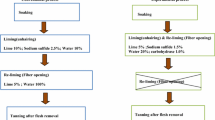Abstract
Conventional leather processing poses serious threat to the environment due to its numerous chemical treatments which include hazardous chemicals such as sodium sulphide and lime. To minimise the pollutants and harmful substances during leather processing, an enzymatic rehydration–dehairing–fibre-opening process has been achieved in shortest possible time compared to conventional process. The physicochemical characteristics of experimental leathers were found to be comparable with those of conventionally processed leathers. The releases of sugar and proteoglycans were found to be in congruence with the scanning electron micrographs and histology. TGA and DSC results ascertained the stability of enzymatically processed leathers. Pollution load in terms of TOC, BOD, COD, and TDS was reduced up to 80% compared to that of the conventional process. The present work provides immense potential for a new approach in leather making with environmental safeguards.

Graphical abstract







Similar content being viewed by others
References
Covington AD (1988) An explanation of an hydrothermal stability anomaly in some chrome tanned leathers. JSLTC 72:30–31
Covington AD (1991) The effects of processing conditions on the hydrothermal stability of chrome leather—part I. constant tanning conditions then ageing. JALCA 86:376–405
Dey PM, Pridham JB (1972) Biochemistry of α-galactosidase. Adv Enzymol 36:911–930
Dubolis M, Gillis KA, Hamilton JK, Rebers PA, Smith F (1956) Anal Chem 28:350–356
Durga J, Ranjithkumar A, Ramesh R, Rose C, Muralidharan C (2015) Rapid fiber opening process for skins: an approach for fail-safe chemical free process. J Am Leather Chem Assoc 110:07–12
Durga J, Ranjithkumar A, Ramesh R, Girivasan KTP, Rose C, Muralidharan C (2016) Replacement of lime with carbohydrases – a successful cleaner process for leather making. J Clean Prod 112:1122–1127
Durga J, Ramesh R, Rose C, Muralidharan C (2017) Role of carbohydrases in minimizing use of harmful substances: leather as a case study. Clean Tech Environ Policy 19:1567–1575
Gupta RK, Prasad D, Sathesh J, Naidu RB, Kamini NR, Palanivel S, Gowthaman MK (2012) Scale-up of an alkaline protease from Bacillus pumilus MTCC 7514 utilizing fish meal as a sole source of nutrients. J Microbiol Biotechnol 22:1230–1236
IUP 2 (2000) Sampling. J Soc Leather Technol Chem 84:303
IUP 6 (2000) Measurement of tensile strength and percentage elongation. J Soc Leather Technol Chem 84:317–321
Jianzhong M, Hou X, Dangge G, Bin L, Jing Z (2014) Greener approach to efficient leather soaking processes: role of enzymes and their synergistic effect. J cleanprod 78:226–232
Kandasamy N, Velmurugan P, Sundarvel A, Jonnalagadda RR, Bangaru C, Palanisamy T (2012) Eco-benign enzymatic dehairing of goat skins utilizing a protease from Pseudomonas fluorescens species isolated from fish visceral waste. J Clean Prod 25:27–33
Lowry OH, Rosebrough NJ, Farr AL, Randall RJ (1951) Protein measurement with the Folin phenol reagent. J Biol Chem 193:265–275
Mantle M, Allen A (1978) Periodic acid/Schiff assay for glycoproteins and mucin. BioChem Soc Trans 6:607–609
Miller J (1972) Experiments in molecular genetics. Cold Spring Harbor Laboratory, NY, pp 352–355
Ranjithkumar A, Durga J, Ramesh R, Rose C, Muralidharan C (2017) Cleaner processing: a sulphide—free approach for depilation of skins. Environ Sci Pollut Res 24:180–188
Rose C, Suguna L, Samivelu N, Rathinasamy V, Ramalingam S, Iyappan K, Parvathaleswara T, Ramasami T (2007) Process for lime and sulfide free unhairing of skins or hides using animal/or plant enzymes. US Patent 7(198):647
Saran S, Mahajan R, Kaushik R, Isar J, Saxena Rajendra K (2013) Enzyme mediated beam house operations of leather industry: a needed step towards greener technology. J Clean Prod 54:315–322
Senthilvelan T, Kanagaraj J, Mandal AB (2012) Application of enzymes for dehairing of skins: cleaner leather processing. Clean Techn Environ Policy 14:889–897
Stark KB, Gallas JM, Zajac GW, Eisner M, Golab JT (2003) Spectroscopic study and simulation from recent structural models for eumelanin: I. monomer, dimers. J Phys Chem B 107:3061–3067
Tran ML, Powell BJ, Meredith P (2006) Chemical and structural disorder in eumelanins: a possible explanation for broadband absorbance. Biophys J 90:743–752
Xu W, Hao L, An Q, Zhou L (2010) Minimization of the environmental impact of leather processing: a benign and enzyme-based integrated leather processing technology. Adv Mater Res 113:1614–1618
Acknowledgements
The authors are thankful to the Director of CSIR – Central Leather Research Institute for his support and encouragement.
Funding
This research received funding from the Council of Scientific and Industrial Research (CSIR), New Delhi. J. Durga received a Senior Research Fellowship from the CSIR-SRF (CSIR – CLRI communication number: A/2018/LPT/CSIR-CLRI/1271).
Author information
Authors and Affiliations
Corresponding author
Additional information
Responsible editor: Philippe Garrigues
Publisher’s Note
Springer Nature remains neutral with regard tojurisdictional claims in published maps and institutional affiliations.
Rights and permissions
About this article
Cite this article
Jayanthi, D., Victor, J.S., Chellan, R. et al. Green processing: minimising harmful substances in leather making. Environ Sci Pollut Res 26, 6782–6790 (2019). https://doi.org/10.1007/s11356-018-04111-z
Received:
Accepted:
Published:
Issue Date:
DOI: https://doi.org/10.1007/s11356-018-04111-z




